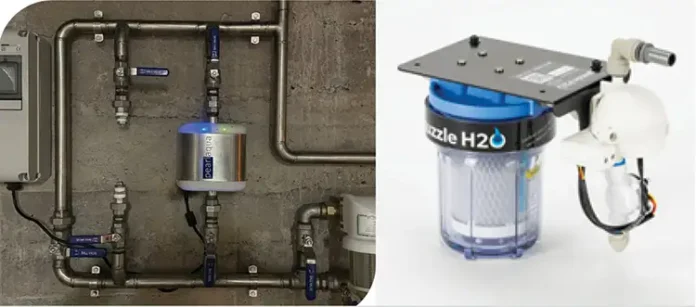By Oliver Lawal and Andrea Martinez, AquiSense Technologies
Unless you’ve been living under a rock in the UV industry, then it’s likely you’ve had more than one conversation about UV-C LEDs in the past few years. Whether you personally believe they already are commercialized, are two years away or are farther than 10 years, it’s undeniable that the tone has shifted from “will they?” to “when will they?” become a commercially viable technology alternative. Within that context also is the question of scale. Will UV photon-generation transition from gas-discharge lamp technology to semiconductor technology in all cases, or is there a physical size/scale limitation?
If this article looks first at what commercialization means, then it could be said that it refers to the systematic introduction of a novel product into the commercial sphere, thereby making it readily available in the market. 1 This process can be thought of as delivering one of two outcomes. Firstly, a “disruptive” product may emerge, displacing established market leaders and revolutionizing entire industries. 2 For instance, visible LEDs were disruptive to existing technologies in various sectors, from display products to automotive lighting to general (ambient) lighting. Secondly, commercialization can result in an “additive” market impact, where the new technology creates an entirely new application area. 2 For example, visible LEDs in smartphones and tablets generated new product categories and applications instead of replacing existing functionalities. This dynamic interplay highlights the continuous growth and evolution of technological markets, driving innovation and diversification.
A key question also revolves around the timing of commercialization. As evident from previous examples, the introduction of LED technology in home televisions was rapid in comparison to the same LED technology adoption in general lighting applications. Several factors influenced the timing of this commercialization, including LED device cost, power consumption, market size dynamics, engineering complexities and the impact of regulatory incentives and disincentives. These multifaceted variables collectively shape the course of technology deployment and market penetration, influencing the pace at which novel innovations become widely accessible and integrated across industries.
Now, let’s turn the focus back to the application of UV-C LED technology for disinfection – more specifically, to larger-scale water treatment. Drawing insights from the commercialization journey of visible LEDs, the authors can explore valuable lessons that may apply to UV-C LEDs. Can timing be accurately predicted? Are there limitations to the scale at which LED technology can be deployed and displace gas-discharge lamps? To what extent can UV-C LED technology contribute to expanding the total UV treatment market by offering additive product solutions? The answers to these questions may provide a deeper understanding of the transformative potential UV LED technology has in water treatment.
Commercialization of Lower Flow UV-C LED Products
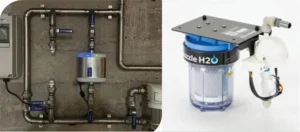
The utilization of UV-C LEDs for water treatment holds considerable potential to deliver the advantages of UV disinfection while mitigating the limitations associated with conventional gas-discharge lamp technology. As is common with all semiconductor-based technologies, operational speed is a key characteristic. The ability to offer immediate disinfection operation at full power, unrestricted on/off cycling, high-power density/unit area, robust system packaging and lack of mercury contamination risk can each be of benefit in specific circumstances. These characteristics of UV-C LEDs have been recognized and documented both at Point-Of-Use (POU) and Point-Of-Entry (POE) scales (Figure 1), which range between flow rates of 0.1 GPM (0.4 LPM) and 15 GPM (58 LPM). Pricing for these products ranges from below $20 each up to over $1,000.
End-user applications invariably consist of compact, self-contained units integrated into broader products or processes – for example, commercial beverage dispensing, ultrapure water generation, recirculating water reuse, medical devices, etc. Other applications include instances where units function as standalone products coupled with filtration for RVs, boats or residential housing. The global market is comprised of several manufacturers of lower-flow-rate UV systems. The authors’ company is one such manufacturer and has reported over 400,000 units installed to date. Considering the average flow rate of these products, the result is a total combined treatment capacity of approximately 600 MGD (~95,000 m3/h).
Applying the previous definition of commercialization, measured as the introduction of a readily available product into an existing market, it would be fair to state that lower-flow UV-C LED-based water treatment products have successfully undergone “commercialization.” However, this does not necessarily indicate that they have attained their full market potential. Furthermore, an additional observation pertains to the role these UV-C LED products have within the market. These systems have demonstrated both disruptive and additive attributes. This dynamic potentially could offer insight into the trajectory of larger-flow-rate UV treatment systems.
The Six Pillars of UV-C LED Commercialization
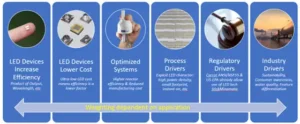
The success in commercializing lower-flow applications using UV LED technology can be attributed to what has been referred to as the “six pillars of UV-C LED commercialization” (Figure 2). 3 This can be seen as a holistic view of the factors influencing such commercialization.
The first two pillars are the continual adoption of best-in-class LED devices as they become commercially available. Improvements in LED device power output, wavelength and other related elements are coupled with the progressive relative reduction in cost of LED devices. This naturally creates room for greater flexibility in optimizing total product price/performance ratio. These trends align with the Haitz Law, originally applied to visible LED development, which states that the cost per lumen of LEDs diminishes by a factor of 10 every decade, while the light output per LED package increases by a factor of 20, considering a specific wavelength. 4 Figure 3 shows data that confirms that UV-C LED development has followed the trend of Haitz’ Law over time. One can, of course, use Haitz Law to preemptively develop product designs that account for UV-C LEDs that will be available in the future, thus reducing the time lag from LED device availability to product commercialization.
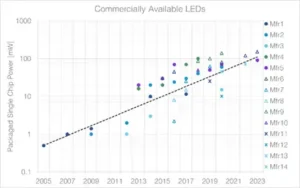
Ultimately, a UV water disinfection product is evaluated on comparative capital and operational costs. These costs are not solely a function of the light source alone, but also include reactor hydrodynamics, optical efficiency, material/assembly/installation cost, footprint, serviceability, etc. 3 Incorporating novel reactor designs that exploit the UV-C LED device characteristics can result in elevated system efficiencies and reduced manufacturing costs. These are included in the third pillar.
Leveraging various inherent characteristics of LEDs can further amplify the advantages of a final product within a process stream. Aspects such as high-power density, compact footprint and instant on/off capabilities play crucial roles in driving specific applications (pillar 4). 3 In higher-flow system applications for municipal and industrial water treatment, the driving factors differ from those in low-flow scenarios. A major cost component in water and wastewater treatment is energy expenditure. Plants with intermittent flow designs, like system batch reactors (SBRs), can benefit from UV LED technology’s inherent capabilities, such as unlimited and instantaneous on/off cycling, leading to reduced overall energy consumption. Additionally, UV LED systems are well-suited for temperature-sensitive plants due to their temperature-independent operation. The compact footprint design of UV LED technology addresses the spatial constraints of some facilities.
Pillar 5 is concerned with regulatory drivers. The landscape already has begun accommodating the utilization of LED technology in the water treatment domain, with standards like ANSI/NSF55 and US EPA UVDGM broadly allowing the use of UV-C LED technology. 3 Other jurisdictions, such as Germany, actively are working on standard updates that account for LED technology. 5 The impact of the United Nations Environmental Program, specifically, the Minamata Convention on Mercury, should not be overstated. 6 However, given the current efforts to end primary mercury mining by 2032, the impact these initiatives could have on the UV disinfection market – and how they serve as a driving force to expand alternative mercury-free solutions 6 – cannot be ignored.
Lastly, the overall industry is propelled by influential drivers such as corporate sustainability goals, increased consumer environmental awareness, water quality concerns and the desire for differentiation in features. Considerations related to lifecycle of capital projects also are becoming a factor, where an end user is cautious to commit to 20-year amortization of capital expense if replacement mercury-vapor lamp costs significantly increase or cannot be guaranteed due to raw-material supply constraints. Collectively, there are industry drivers steering the UV disinfection domain toward a mercury-free market that do not necessarily require equal-cost parity – as witnessed in other new technology areas, such as renewable energy and EV transportation.
As mentioned earlier, each of these six pillars vary in significance depending on the application; therefore, it is not possible to develop a simple formula that universally can be applied. That said, choosing to ignore key commercialization factors could leave an equipment manufacturer, design consultant or end user in a position where the most appropriate choice is not made.
Companies like the author’s organization remain deeply committed to ongoing product development and integration pathways for LED technology. Numerous comprehensive case studies, conducted by various organizations, have provided invaluable insights into the feasibility and effectiveness of incorporating larger scale UV-LED systems into municipal and industrial water treatment practices. These case studies serve as essential references to assess the potential viability and performance of such implementations.
Case Study 1: Municipal Drinking Water, United Kingdom
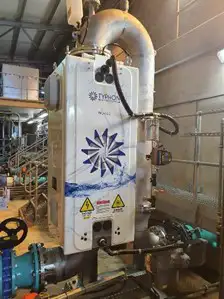
United Utilities successfully installed a Typhon Treatment system in Cumbria, with a flow rate of 28 million liters per day (MLD) and a target dose of 22 mJ/cm2, achieving a 4-log reduction in Cryptosporidium. 7 The small footprint of UV LEDs was pivotal in accommodating the reactor within the required 1.5-meter inline pipework section. This system, pictured in Figure 4, has been validated in accordance with US EPA guidelines outlined in the UV Disinfection Guidance Manual, 2006.
Case Study 2: Ground Water Legionella Treatment, Nevada USA
Las Vegas Valley Water District and Southern Nevada Water Authority in the United States have implemented multiple PearlAqua Tera systems from the authoring company. There are an initial six installations treating a flow rate ranging from 315 to 1,500 m3/hr (2MGD to 9.5 MGD), employing UV dose values in the range of 20 to 40 mJ/cm2, with a primary focus on Legionella inactivation. 8 The sustainability aspect of LED systems, reduced contamination risk of the distribution network and literature supporting UV LEDs’ increased Legionella inactivation efficiency contributed to the technology selection in this application.
Case Study 3: Water Discharge Treatment, Nova Scotia, Canada
Dalhousie University conducted research on UV LED disinfection for water discharge, utilizing bench-scale apparatus. This study compares UV LED technology with existing low-pressure (LP) gas-discharge lamps in seasonal streams. Data from this study showed that a significant amount of energy is wasted by the LP system due to an excessive applied UV fluence. 9 A full-scale PearlAqua Kilo system (from the authors’ company) and capable of providing a UV dose ranging from 20 to 60 mJ/cm2 will be operational in mid-2023 at the same wastewater treatment facility in Nova Scotia and will be used to validate these findings by operating alongside an existing LP system.
Case Study 4: Potable Water Reuse, Maryland, USA
Potable reuse represents another potential application. HDR aims to bolster long-term water supply resiliency and water quality in Chesapeake Bay. To this end, the PearlAqua Kilo system has been implemented in a pilot system engineered by Intuitech to provide a variable UV dose spanning from 40 to 1,000 mJ/cm2 for disinfection and advanced oxidation treatment options.
Case Study 5: Mobile Water Treatment Unit, Colorado, USA
The University of Colorado Boulder contributed to the design of a pilot study exploring a mobile unit that can treat diverse water sources. Employing a PearlAqua Kilo system, this study delivers a variable UV dose ranging from 40 to 1,000 mJ/cm2 for disinfection and advanced oxidation. The objective involves operating the unit as an advanced oxidation process (AOP) by injecting either hydrogen peroxide or free chlorine into the water upstream of the UV unit. The study aims to compare the capital cost of operation, electrical energy usage per unit of chemical reduction or disinfection and the cost of chemical inputs and other materials in conventional LP systems vs. UV LED systems.
Conclusion
Within the context of UV-C LED technology commercialization, a retrospective glance from 2013 unveils a landscape characterized by very few suppliers offering costly, low-powered devices. Nonetheless, a few bold developers were the ones who saw the potential and started to incorporate these UV-C LED devices into treatment products. These products also became more widely available to academic researchers, igniting studies into novel application domains, comparative analyses and establishing well-known UV dose response curves and efficiency metrics. As the trajectory of LEDs, coupled with the critical facet of device packaging, followed a predictable efficiency/cost trend, the era of innovating and pioneering novel UV began. A decade later, the global market was filled with hundreds of thousands of lower-flow systems, serving an expansive range of applications that both challenge and enhance preexisting UV markets.
The question then arises: Can this 10-year timeframe be transposed onto the commercialization of larger flow UV disinfection systems? The answer appears subjective. Nonetheless, a pivotal marker lies in the installation of the first large-scale system in the UK over two years ago, with an array of additional full-scale and pilot systems set to begin operations. It would be difficult to deny that the early adoption stage already is underway. With the pace of adoption only being partially predictable by LED device development, as described by Haitz, a comprehensive evaluation of all six pillars of commercialization should be accounted for in the evaluation of timing. Arguably, the second wave of adoption may surge at an accelerated pace, driven by lessons learnt from the development of lower flow systems – a phenomenon that mirrors the rapid evolution often witnessed in disruptive commercialization.
Is there a scale constraint? This question hinges significantly upon the extent of engineering efforts. Products utilizing UV-A/B in curing and printing applications substantiate the absence of scalability limitations, as modular assemblies facilitate market expansion. This pattern also is notably observed in the expansive market of visible LED arrays. The progression to large-flow systems introduces new challenges, such as footprint optimization, serviceability and power consumption. As previously highlighted, there are multiple applications where the processes would benefit greatly from the characteristics of LED devices. While the present discussion steers away from delving into the nuances, it remains an important point to recognize applications where conventional gas-discharge technology simply cannot meet the application demands. Hence, there are market applications where higher-flow UV-C LED systems can integrate into the market in an additive manner.
As operational data from the early adopters of larger-scale systems gradually becomes public, it will become evident how UV-C technology fares against conventional UV systems. Additional technical/market drivers, or commercialization pillars, will determine the outcome. Undeniably, this is a very active area of application research and product engineering development. A powerful synergy is formed by the macro trends of increased water quality demands, sustainability and regulatory compliance. Given that semiconductor technologies have consistently demonstrated enhanced commercial viability in contrast to analog technologies, it would take a brave person to place a bet against increased deployment of UV-C LEDs within water treatment. The critical question: How long will it take? Time will tell.
References
- Clarke, A. (2016). Commercialization. In: Jafari, J., Xiao, H. (eds) Encyclopedia of Tourism. Springer, Cham. https://doi.org/10.1007/978-3-319-01384-8_436
- Thiel, P, Masters, B. (2014). Zero to one: notes on startups, or how to build the future. New York: Crown Business.
- Lawal, O. (2023, April). UV-C LED Water Disinfection: From Emerging Technology to Established Market [Conference presentation]. ICULTA 2023, Berlin, Germany.
- Haitz’s law. (2007). Nature Photonics, 1(1), 23. https://doi-org.libezp.lib.lsu.edu/10.1038/nphoton.2006.78
- Eggers, J. (2023, April). Upcoming standard for the use of UV LEDs in public drinking water disinfection [Conference presentation]. ICULTA 2023, Berlin, Germany.
- “Minamata Convention on Mercury: Timeline.” Timeline | Minamata Convention on Mercury, mercuryconvention.org/en/about/timeline. February 2023.
- Typhon Treatment Systems Ltd., BIO-310 UV LED Reactor. AquaTech 2021, Amsterdam, Neatherlands.
- Stevens, Liz. “A Focus on UV Led Technology and AOP Applications in Water – UV Solutions.” UV Solutions – Innovations for Industry, Public Health & the Environment, 14 Mar. 2023, uvsolutionsmag.com/articles/2023/a-focus-on-uv-led-technology-and-aop-applications-in-water/.
- MacIsaac, S.A., Rauch, K.D., Prest, T. et al. Improved disinfection performance for 280 nm LEDs over 254 nm low-pressure UV lamps in community wastewater. Sci Rep 13, 7576 (2023). https://doi.org/10.1038/s41598-023-34633-7
AquiSense Technologies is the global leader in UV-C LED systems design and manufacture that solves real world problems in water, air, and surface disinfection applications. As the world’s largest UV LED disinfection systems supplier, AquiSense is uniquely positioned to find solutions in a number of applications. For more information, visit www.aquisense.com.


